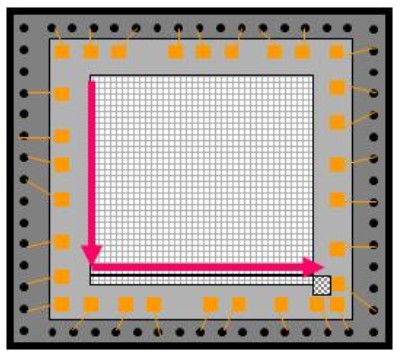Transport and conversion of the charge
Fondamental :
The charge is transferred successively from gate to gate, and finally converted at the output node. The quality of the output signal directly depends on two vital parameters: the Charge Transfer Efficiency and the efficiency of the output conversion.

Charge transfer efficiency
The charge transfer efficiency allows us to quantify the quality of the passage of the charge from one gate to another, from one pixel or line/column to another, and through the gates of the reading shift register. The charge transfer efficiency of a gate is often very close to 1, however, the slightest deviation can have a huge impact on the final signal depending on the size and number of transfers from one to another. It can be compared to the amount of water that would remain in a bucket after transferring all its content into an other bucket nearby. The percentage of the initial amount of water transferred into the second bucket is the CTE. Good-quality CCDs have a CTE close to \(99.999\%\).
If we take again the example of the Fairchild CCD595 sensor, the number of pixels is of \(9216\) by \(9216\), with \(3\) gates by pixel. Transferring information from the top pixel to the bottom one and through the output register requires \(9216\times 3=27648\) transfers. The vertical charge transfer efficiency is about \(99.9999\%\) so only \(0.0001\%\) of the signal is lost. For the \(27948\) transfers, only \(2.7\%\) of the charge will be lost. For this particular sensor, the horizontal charge transfer efficiency is slightly different because the information only travels through \(1/4\) of the pixel number to reach the output node, and a system with only two gates is used for each of the four output registers. The horizontal charge transfer efficiency is about \(99.995\%\) and so leaves \(2.2\%\) of charge lost for the last pixel.
Remarque :
If the CTE of a CCD is very bad, streaks can even appear on the image.
Output structure
At the end of its journey through the different gates, the charge is finally converted into voltage by a floating diode or a floating diffusion.
The voltage difference between the final state of the diode and its pre-stored value is linearly proportional to the number of electrons, \(n_{e}\). The signal voltage after the source is:
The gain \(G\) is approximately equal to \(1\), \(q\) is the charge of the electron and the charge conversion rate \(\text{Gq/C}\) typically varies between \(0.1\text{ }\mu\text{V/e}^{-}\) and \(10\text{ }\mu\text{V/e}^{-}\). Then, the signal is amplified, processed, and digitized by electronic systems external to the CCD sensor.